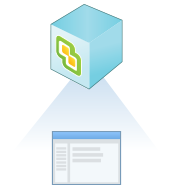You can use the GUI installer to perform an interactive deployment of a vCenter Server Appliance with an embedded Platform Services Controller, a Platform Services Controller appliance, or a vCenter Server Appliance with an external Platform Services Controller.
When you perform the GUI deployment, you download the vCenter Server Appliance installer on a network client machine, run the deployment wizard from the client machine, and provide the inputs that are required for the appliance deployment and setup.
The GUI deployment process includes a series of two stages.

The first stage walks you through the deployment wizard to choose the deployment type and appliance settings. This stage completes the deployment of the OVA file on the target server with the deployment type and appliance settings that you provide.
As an alternative to performing the first stage of the deployment with the GUI installer, you can deploy the OVA file of the vCenter Server Appliance or Platform Services Controller appliance by using the vSphere Web Client or VMware Host Client. To deploy the OVA file on an ESXi host or vCenter Server instance 5.5 or 6.0, you can also use the vSphere Client. After the OVA deployment, you must log in to the appliance management interface of the newly deployed appliance to proceed with the second stage of the deployment process.

The second stage walks you through the setup wizard to configure the appliance time synchronization and vCenter Single Sign-On. This stage completes the initial setup and starts the services of the newly deployed appliance.
As an alternative to performing the second stage of the deployment with the GUI installer, you can log in to the Appliance Management Interface of the newly deployed appliance, https://FQDN_or_IP_address:5480.